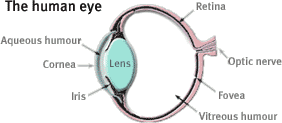A page from the "Causes of Color" exhibit...
What happens in the eye?


The human eye showing the lens and the optic nerve.
The sight of a rainbow can boost our spirits, and the fine details of an exquisite painting can move us to tears. Yet, we often grope around in the dark – even when we’re in familiar surroundings. We may take the ability to see for granted, but vision arises out of the interplay between complex components.
How does our eye see?
Light from external objects enters the eye through the pupil. The human eye has a lens and iris diaphragm that work much like a camera. The optics of the eye project an upside-down image of those objects on the rear, inner surface of the eyeball (the retina). There, a dense carpet of light-sensitive photoreceptors converts light (photons) into electro-chemical signals, which are then processed by neural circuits in the retina and transmitted to the brain.
The retina consists of a very thin layer of nerve cells and contains two types of photoreceptors, rods and cones. Ganglions are also located in the retina.
Ganglions are a type of neuron located in the retina that receive signals via various intermediate cells from the cones and rods. They are the cells that transmit the information to the brain.
The numbers of rods and cones vary over the surface of the retina. Rods are located mainly in the peripheral retina and are absent in the middle of the fovea (the center of the retina). Cones are located throughout the retina but are concentrated in the very center of the retina.
The rods, which are more numerous than cones, are responsible for our vision in dim light but don’t function in bright light. Rods account for our night vision but cannot distinguish color. Our eyes are very sensitive at night, but we don’t see well straight in front of us.
Cones are active at high light levels and allow us to see color and fine detail directly in front of us. They can adapt to widely varying colors and illumination levels, but don’t work well in low light.
Our peripheral vision is very good at detecting movement in a wide variety of illumination levels but is poor at low-resolution imaging and provides very little color information. Thanks to the retinal layer, which covers most of the eye’s inner chamber, our visual system is like a motion sensor with nearly 180 degrees of horizontal coverage. This motion detection has been useful to humankind for millennia, and was once used as an early warning system for aggressors and for spotting game while hunting.





